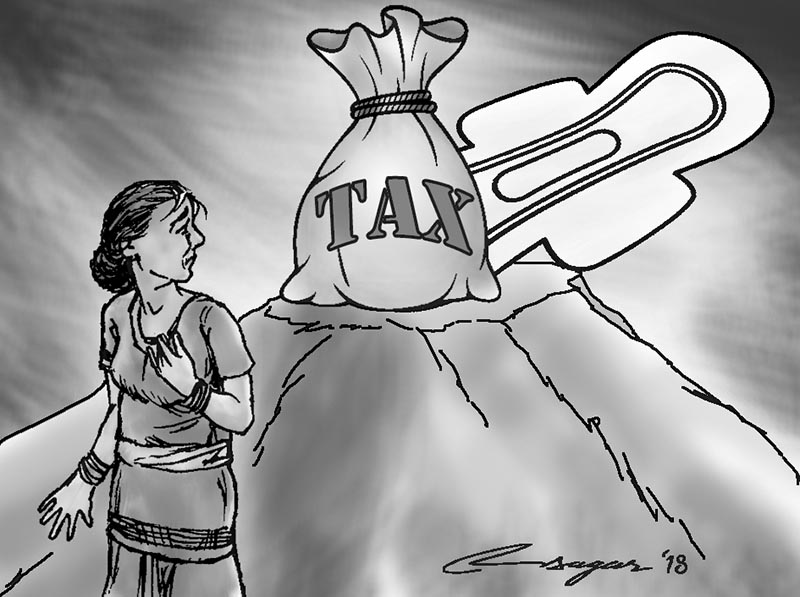Expensive periods: Why tax on pads?
Menstruation is a natural phenomenon. While there are stigmas attached with periods, handling them has become costly due to tax on sanitary pads. There is no calculation for the cost of discomfort
Last week, I was on a public bus going to college when I met a woman, probably in her mid-30s. She was sitting next to me. As I was in college uniform, she asked me about my studies. During the conversation, I came to know she was from Nuwakot. To carry on with the conversation I asked her what brought her to Kathmandu, about life of women in her district and rural villages and so on and so forth.
She told me she was going to the hospital for a follow-up of her early stage cervical cancer. We also talked about her — and other rural women’s — menstruation experience. I was horrified to learn how miserable situation women are in rural areas during their periods. She is just a representative character — thousands of women in Nepal go through the similar ordeal just because they cannot afford sanitary pads during their periods.
One of the interesting facts is that the cost of monthly periods is twice than the pain of menstrual cramps. The costs associated with sanitary pads, pain relievers, chocolate or sugary treats during premenstrual syndrome, heating pads, etc add up to the monthly expenses.
It is not a choice for women, but a recurring monthly cost, which is not affordable for most of the women in Nepal. Many of rural women in Nepal still use old clothes, rags, and sometimes even leaves, to absorb the menstrual blood which is one of the causes of cervical cancer. And the easiest solution to prevent such Reproductive Tract Infections (primarily) is use of sanitary pads.
The World Health Organisation estimates that the crude incidence rate of cervical cancer in Nepal is 24.2 per 100,000 women per year, with 3,504 new cases diagnosed every year and 1,872 deaths. On the other hand, we can’t ignore the fact that most of the sanitary pads are made in India and so we are paying double for sanitary pads here.
Is it the cost of advertisement or the charge of transportation that we are paying the hefty amount on these materials? In India, sanitary pads were taxed at 12 per cent under Goods and Services Tax launched in July. But later it scrapped tax. It was a good initiative by the government in India. But we in Nepal are yet to take cognizance of this.
Generally, the average days of having a period are three to seven days and women menstruate from the age of 13 until age 51. On an average, a woman bears some 456 total periods over the 38 years or roughly 2,280 days with her period — or 6.25 years of her life.
Mainly, it is instructed to change the pads every four to six hours, so on an average women use it for five hours. A packet containing six pads costs at least Rs 70 at local shops. The price, however, may differ based on brands and places where they are bought. Even a basic pad that is bulky and uncomfortable, which costs around Rs 5-7 for one, is now rarely available in Kathmandu. While the branded, longer, perfumed, equipped with wings with good adhesive and better absorbents can cost Rs 10- 12 per pad.
Let’s try to have a rough calculation. It’s one pad every five-six hours equals four pads per day (subject to change based on the flow). If we take average period days as four, it will mean 16 pads per cycle. Now a total of 456 periods will result in 7,296 pads. With six pads per packet, a woman has to buy around 1,216 packets and Rs 70 per packet results in Rs 85,120. There is no calculation for the cost of discomfort.
This doesn’t even include the cost of reproductive health check-ups and other visits to the doctor. While sanitary pads are easily available in urban centres, it’s not easy for women in rural areas to buy on.
Girls and women in rural areas also face a multitude of taboos around menstruation just because they can’t afford sanitary pads. Activists of late therefore have been working to make menstruation hygiene and sanitary pads easily accessible. Also they are questioning: if contraceptive and condoms are tax-free, why are sanitary pads being taxed?
The irony is that half of the population will never have to pay a hefty cost of having a period. We can say that only women can feel the economic effect because women have no choice but to buy these products. Even we can’t just ignore our period and its requirements.
Many organisations, schools and even individuals have been educating and informing girls about menstruation and hygiene practices in different parts of Nepal. It is really an appreciable work.
If sanitary pads or cloths are easily available and openly discussed, then the expenses and health problem caused by poor sanitation during menstruation can largely be reduced. Not only this, women should be taught to dispose of sanitary pads properly. Having a period when you are poor means you have additional stress to find a way for paying the needy essentials on every month.
In my locality most of the married females refuse to wear sanitary pads. It is not because it is unavailable but because it is expensive. If sanitary pads are available at minimum price, no one would have to opt for the itchy and unhealthy materials during their periods. It’s time to make sanitary pads tax-free. Last but not least, easy availability of sanitary pads can tackle one of the biggest barriers to education for girls, as they are who forced to stay at home during their periods due to a lack of access to clean hygiene products, while also facing stigma and a lack of toilets and water in schools.






